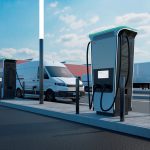Cracks in the tar, rust on the rails: is this our future?
Cracks in the tar, rust on the rails: is this our future?
Ever wondered what the transport infrastructure in South Africa (what’s left of it) will look like in 10 years? I worry that I know the answer…
Every time I read one of Nick Porée’s columns, I brace myself. I know I’m about to be punched in the gut by facts that are not just painful – they’re undeniable. It’s not his tone that breaks me. Nick is never hysterical, never melodramatic. He doesn’t need to be. He simply lays out the truth. It is cold and methodical, and that’s what makes it so devastating.
His latest piece on the withdrawal of US aid and the collapse of our transport systems on page 12 of this issue should be pasted on every government office wall and read aloud at every portfolio committee. It won’t be, though, and that’s exactly why I worry that I can predict the next decade of transport in South Africa.
I’m not a pessimist by nature. I’ve worked in this industry long enough to have seen its resilience and its flashes of brilliance – even amid dysfunction. But reading Nick’s piece, I couldn’t help but see what’s coming – not because I want to, but because it’s already underway. Ten years from now, if we continue down this path, our transport infrastructure may not just be inefficient – it could be near collapse.
Ports in paralysis
Let’s start at the coast: in 10 years, our ports could resemble ghost towns, relatively speaking. Ships will still dock, of course, but fewer and fewer will bother. The inefficiency, the delays, the broken equipment – none of that will have magically fixed itself.
Without private investment and clear-headed leadership, I fear the terminal operators of 2035 will still be cannibalising spare parts from 30-year-old cranes. Brazil will have sold off its port terminals to competitive bidders, bringing in revenue, skills, and modern tech. We, meanwhile, will be holding on to the fantasy of public ownership while the rest of the world sails past us.
Nick points out that we could’ve had world-class terminals for a fraction of what Transnet has blown over the years. That line haunts me. It should haunt all of us.
Ruined roads and rotten railroads
What about our roads? Today, 60% of our freight vehicles are unroadworthy. Ten years from now, that number could be even higher, especially if the Vehicle Overloading Management System (VOMS) remains a paper tiger, roaring with data but toothless when it comes to enforcement. If current trends continue, the roads will be so potholed and eroded that routes between major logistics hubs could take twice as long to navigate. Transport costs will skyrocket. Food, fuel, medicine… everything will get more expensive.
And rail? Well, if you’re hoping for a revival of the golden age of trains, prepare for disappointment. The so-called “revitalisation” efforts under the Transnet Railway Infrastructure Manager (TRIM) plans are still pinned to the state-owned model. That model has already failed us, and unless we make a radical shift to encourage commercial private rail operators, we’re just dressing up a corpse and pretending it’s dancing. In 2035, our freight trains may still be waiting for permission, waiting for spares, waiting for leadership – waiting for a future that never comes.
Border bottlenecks and missed opportunities
Nick mentions the One-Stop Border Post (OSBP) model in East Africa – a model that has worked. It is efficient, logical, and proven. Here, we’re still fumbling with bureaucracy and border chaos. In a decade, our border posts could be even more congested, strangling trade with delays and red tape. Meanwhile, our neighbours – yes, even Zimbabwe and the DRC – may have leapfrogged us by embracing public-private partnerships and technological upgrades.
We had the opportunity to lead in Africa. In 10 years, we may be reduced to following – poorly.
The skills cliff
Let’s talk about people. Or rather, the alarming shortage of skilled ones. The collapse of the apprenticeship system is a timebomb. By 2035, we could face a crisis of such proportions that we’ll struggle to find anyone competent to maintain even the existing systems – let alone install new ones. Driver training is already in tatters. Technician education? Practically non-existent. The universities that should be shaping the next generation of transport leaders have abandoned practical training entirely.
I dread the thought of transport companies relying on Google searches to repair vehicles and manage fleets. But, if things don’t change, that’s where we’re headed.
Climate change and the false promise of green tech
It would be comforting to imagine that a green revolution will save us. But South Africa’s energy grid is already buckling under the pressure of current demand. Add fleets of electric vehicles, fast-charging stations, and hydrogen plants, and we may tip into full-blown infrastructural collapse. Nick is right to be sceptical: renewable energy isn’t magic. Batteries expire; solar panels degrade. Without the industrial base to manufacture and recycle, we’re simply importing problems under a green label.
A fork in the road
By now, you might think I’ve lost all hope. I haven’t – not completely. But I am deeply worried. Nick’s piece reads like prophecy, but it’s not mystical; it’s just logical. If we keep spending 37% of the national budget on 2% of the population – namely, overpaid public servants – there will be no money left for the hospitals, schools, or infrastructure that form the skeleton of a modern nation.
In 10 years, South Africa’s transport system might be marked by:
• Ports running at 30% efficiency.
• A rail network used only by nostalgia tourists.
• Road freight carriers running unlicensed and overloaded vehicles on crumbling tar.
• Airports under chronic strain from unqualified air traffic controllers.
• Border delays so severe that trade agreements become meaningless.
And all the while, those of us in the industry will keep doing what we’ve always done – fighting fires, improvising, hoping for leadership.
I hope I’m wrong
So, what will South African transport look like in 2035? If I’ve made you feel despair, then good – it’s time we all felt it. Because only from that depth can we find the will to rise. We need to stop pretending the system can fix itself. We need radical reform, not bureaucratic tinkering. We need to make space for the private sector to step in where the public sector has failed. And we need to value expertise – not just in rhetoric, but in policy and practice.
But above all, I pray – fervently – that I’m wrong: that this bleak picture doesn’t materialise; that our leaders heed the warnings from voices like Nick Porée; that the next decade surprises us not with collapse, but with courage. For now, though, it’s hard to shake the feeling that the pigs will, as Nick says, keep drinking the milk – while the rest of us are left watching the transport wheels fall off.
Published by
Charleen Clarke
focusmagsa




